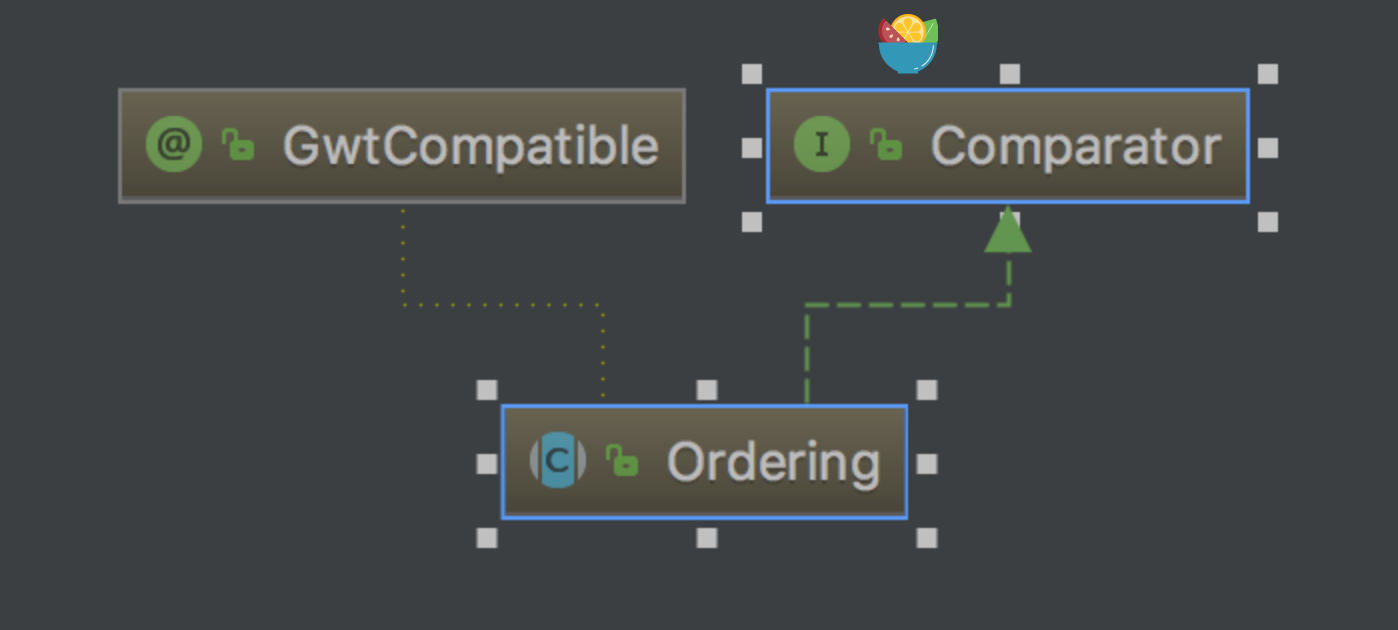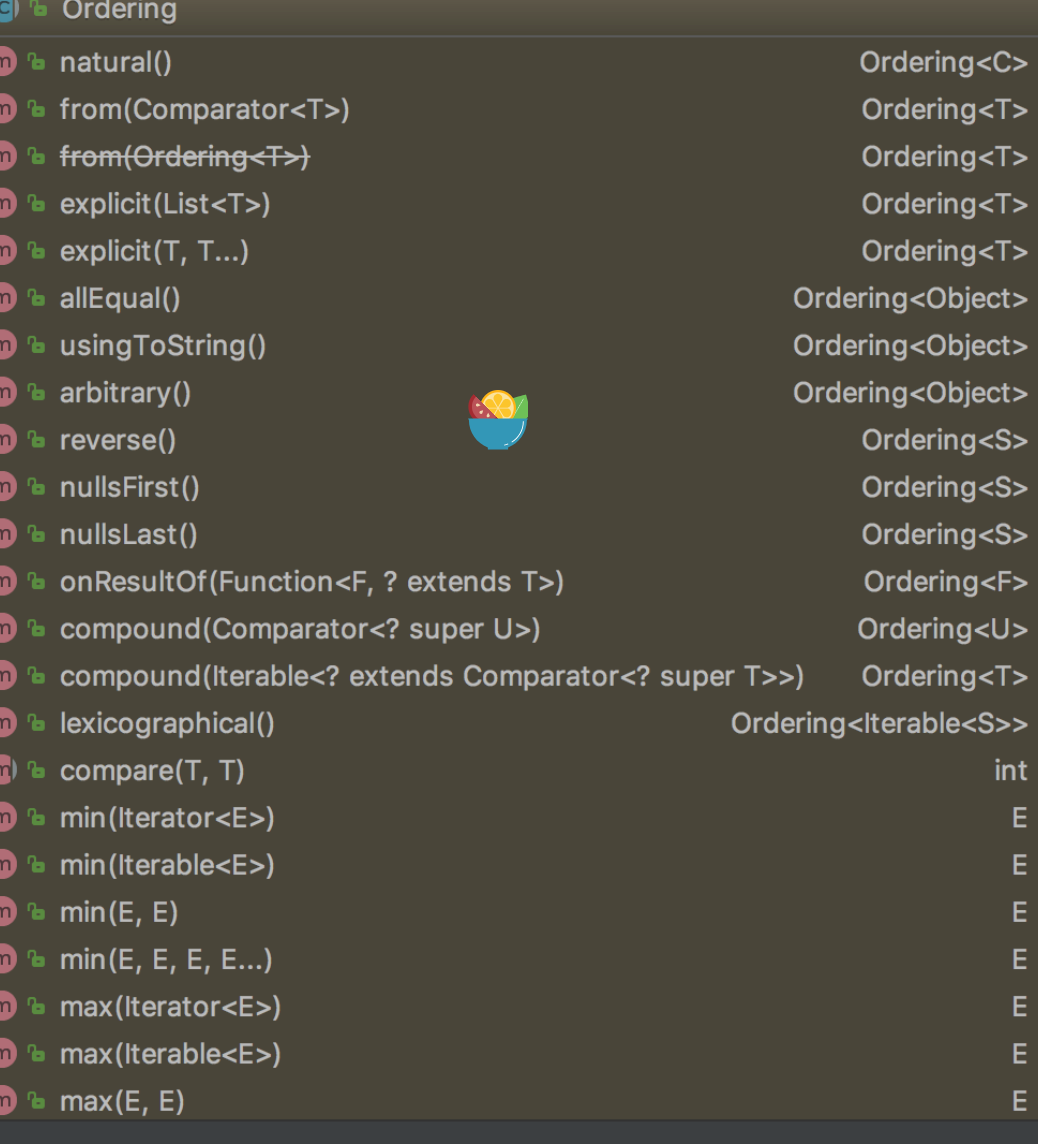背景
这年头想必没几个人没写过排序吧。。。而在jdk也默认提供了许多和排序相关的封装。
我们最常使用的想必就是
/** * Sorts the specified list into ascending order, according to the * {@linkplain Comparable natural ordering} of its elements. * All elements in the list must implement the {@link Comparable} * interface. Furthermore, all elements in the list must be * <i>mutually comparable</i> (that is, {@code e1.compareTo(e2)} * must not throw a {@code ClassCastException} for any elements * {@code e1} and {@code e2} in the list). * * <p>This sort is guaranteed to be <i>stable</i>: equal elements will * not be reordered as a result of the sort. * * <p>The specified list must be modifiable, but need not be resizable. * * <p>Implementation note: This implementation is a stable, adaptive, * iterative mergesort that requires far fewer than n lg(n) comparisons * when the input array is partially sorted, while offering the * performance of a traditional mergesort when the input array is * randomly ordered. If the input array is nearly sorted, the * implementation requires approximately n comparisons. Temporary * storage requirements vary from a small constant for nearly sorted * input arrays to n/2 object references for randomly ordered input * arrays. * * <p>The implementation takes equal advantage of ascending and * descending order in its input array, and can take advantage of * ascending and descending order in different parts of the same * input array. It is well-suited to merging two or more sorted arrays: * simply concatenate the arrays and sort the resulting array. * * <p>The implementation was adapted from Tim Peters's list sort for Python * (<a href="http://svn.python.org/projects/python/trunk/Objects/listsort.txt"> * TimSort</a>). It uses techiques from Peter McIlroy's "Optimistic * Sorting and Information Theoretic Complexity", in Proceedings of the * Fourth Annual ACM-SIAM Symposium on Discrete Algorithms, pp 467-474, * January 1993. * * <p>This implementation dumps the specified list into an array, sorts * the array, and iterates over the list resetting each element * from the corresponding position in the array. This avoids the * n<sup>2</sup> log(n) performance that would result from attempting * to sort a linked list in place. * * @param list the list to be sorted. * @throws ClassCastException if the list contains elements that are not * <i>mutually comparable</i> (for example, strings and integers). * @throws UnsupportedOperationException if the specified list's * list-iterator does not support the {@code set} operation. * @throws IllegalArgumentException (optional) if the implementation * detects that the natural ordering of the list elements is * found to violate the {@link Comparable} contract */ public static <T extends Comparable<? super T>> void sort(List<T> list) { Object[] a = list.toArray(); Arrays.sort(a); ListIterator<T> i = list.listIterator(); for (int j=0; j<a.length; j++) { i.next(); i.set((T)a[j]); } }
问题
虽然通常来说我们使用jdk的默认已经足够 但是始终会有一些莫名其妙的问题要来。
比如使用sort接口要求必须实现 Comparable 前几篇文章我们也聊过关于 Comparable这个接口在官方说明中
/** * Compares this object with the specified object for order. Returns a * negative integer, zero, or a positive integer as this object is less * than, equal to, or greater than the specified object. * * <p>The implementor must ensure <tt>sgn(x.compareTo(y)) == * -sgn(y.compareTo(x))</tt> for all <tt>x</tt> and <tt>y</tt>. (This * implies that <tt>x.compareTo(y)</tt> must throw an exception iff * <tt>y.compareTo(x)</tt> throws an exception.) * * <p>The implementor must also ensure that the relation is transitive: * <tt>(x.compareTo(y)>0 && y.compareTo(z)>0)</tt> implies * <tt>x.compareTo(z)>0</tt>. * * <p>Finally, the implementor must ensure that <tt>x.compareTo(y)==0</tt> * implies that <tt>sgn(x.compareTo(z)) == sgn(y.compareTo(z))</tt>, for * all <tt>z</tt>. * * <p>It is strongly recommended, but <i>not</i> strictly required that * <tt>(x.compareTo(y)==0) == (x.equals(y))</tt>. Generally speaking, any * class that implements the <tt>Comparable</tt> interface and violates * this condition should clearly indicate this fact. The recommended * language is "Note: this class has a natural ordering that is * inconsistent with equals." * * <p>In the foregoing description, the notation * <tt>sgn(</tt><i>expression</i><tt>)</tt> designates the mathematical * <i>signum</i> function, which is defined to return one of <tt>-1</tt>, * <tt>0</tt>, or <tt>1</tt> according to whether the value of * <i>expression</i> is negative, zero or positive. * * @param o the object to be compared. * @return a negative integer, zero, or a positive integer as this object * is less than, equal to, or greater than the specified object. * * @throws NullPointerException if the specified object is null * @throws ClassCastException if the specified object's type prevents it * from being compared to this object. */ public int compareTo(T o);
在对应为空抛出空指针。不过这个逻辑被大家的实现覆盖的比较多了。但是我们也不能保证所有的比较器都会特殊处理null。
比如一个典型的例子
@Test(expected = NullPointerException.class) public void testDefaultSortString(){ List<String> list = Lists.newArrayList("1","2","2222","我是中国人",null,null,"222"," ","","aaa"); System.out.println("Input List: "); System.out.println(list); Collections.sort(list); System.out.println("sort List: "); System.out.println(list); }
这个在string为空比较就会抛出空指针。比较头疼
/** * Compares two strings lexicographically. * The comparison is based on the Unicode value of each character in * the strings. The character sequence represented by this * <code>String</code> object is compared lexicographically to the * character sequence represented by the argument string. The result is * a negative integer if this <code>String</code> object * lexicographically precedes the argument string. The result is a * positive integer if this <code>String</code> object lexicographically * follows the argument string. The result is zero if the strings * are equal; <code>compareTo</code> returns <code>0</code> exactly when * the {@link #equals(Object)} method would return <code>true</code>. * <p> * This is the definition of lexicographic ordering. If two strings are * different, then either they have different characters at some index * that is a valid index for both strings, or their lengths are different, * or both. If they have different characters at one or more index * positions, let <i>k</i> be the smallest such index; then the string * whose character at position <i>k</i> has the smaller value, as * determined by using the < operator, lexicographically precedes the * other string. In this case, <code>compareTo</code> returns the * difference of the two character values at position <code>k</code> in * the two string -- that is, the value: * <blockquote><pre> * this.charAt(k)-anotherString.charAt(k) * </pre></blockquote> * If there is no index position at which they differ, then the shorter * string lexicographically precedes the longer string. In this case, * <code>compareTo</code> returns the difference of the lengths of the * strings -- that is, the value: * <blockquote><pre> * this.length()-anotherString.length() * </pre></blockquote> * * @param anotherString the <code>String</code> to be compared. * @return the value <code>0</code> if the argument string is equal to * this string; a value less than <code>0</code> if this string * is lexicographically less than the string argument; and a * value greater than <code>0</code> if this string is * lexicographically greater than the string argument. */ public int compareTo(String anotherString) { int len1 = value.length; int len2 = anotherString.value.length; int lim = Math.min(len1, len2); char v1[] = value; char v2[] = anotherString.value; int k = 0; while (k < lim) { char c1 = v1[k]; char c2 = v2[k]; if (c1 != c2) { return c1 - c2; } k++; } return len1 - len2; }
因此关于一些特殊值的处理需要注意。
Ordering
Guava在这一块很有经验。
通常使用Ordering进行一些比较。

实现了java的Comparator接口 通常我们使用一些静态方法进行Ordering的创建

通常我们使用如下一些方法
| S.N. | 方法及说明 |
| 1 | static Ordering<Object> allEqual()
返回一个排序,它把所有的值相等,说明“没有顺序。”通过这个顺序以任何稳定的排序算法的结果,在改变没有顺序元素。 |
| 2 | static Ordering<Object> arbitrary()
返回一个任意顺序对所有对象,其中compare(a, b) == 0 意味着a == b(身份平等)。 |
| 3 | int binarySearch(List<? extends T> sortedList, T key)
搜索排序列表使用键的二进制搜索算法。 |
| 4 | abstract int compare(T left, T right)
比较两个参数的顺序。 |
| 5 | <U extends T> Ordering<U> compound(Comparator<? super U> secondaryComparator)
返回首先使用排序这一点,但它排序中的“tie”,然后委托给secondaryComparator事件。 |
| 6 | static <T> Ordering<T> compound(Iterable<? extends Comparator<? super T>> comparators)
返回一个排序它尝试每个给定的比较器,以便直到一个非零结果找到,返回该结果,并返回零仅当所有比较器返回零。 |
| 7 | static <T> Ordering<T> explicit(List<T> valuesInOrder)
返回根据它们出现的定列表中的顺序比较对象进行排序。 |
| 8 | static <T> Ordering<T> explicit(T leastValue, T... remainingValuesInOrder)
返回根据它们所赋予本方法的顺序进行比较的对象进行排序。 |
| 9 | static <T> Ordering<T> from(Comparator<T> comparator)
返回基于现有的比较实例进行排序。 |
| 10 | <E extends T> List<E> greatestOf(Iterable<E> iterable, int k)
返回根据这个顺序给出迭代,为了从最大到最小的k个最大的元素。 |
| 11 | <E extends T> List<E> greatestOf(Iterator<E> iterator, int k)
返回从给定的迭代器按照这个顺序,从最大到最小k个最大的元素。 |
| 12 | <E extends T> ImmutableList<E> immutableSortedCopy(Iterable<E> elements)
返回包含的元素排序这种排序的不可变列表。 |
| 13 | boolean isOrdered(Iterable<? extends T> iterable)
返回true如果在迭代后的第一个的每个元素是大于或等于在它之前,根据该排序的元素。 |
| 14 | boolean isStrictlyOrdered(Iterable<? extends T> iterable)
返回true如果在迭代后的第一个的每个元素是严格比在它之前,根据该排序的元素更大。 |
| 15 | <E extends T> List<E> leastOf(Iterable<E> iterable, int k)
返回根据这个顺序给出迭代,从而从低到最大的k个最低的元素。 |
| 16 | <E extends T> List<E> leastOf(Iterator<E> elements, int k)
返回第k从给定的迭代器,按照这个顺序从最低到最大至少元素。 |
| | |
| 17 | <S extends T> Ordering<Iterable<S>> lexicographical()
返回一个新的排序它通过比较对应元素两两直到非零结果发现排序迭代;规定“字典顺序”。 |
| 18 | <E extends T> E max(E a, E b)
返回两个值按照这个顺序的较大值。 |
| 19 | <E extends T> E max(E a, E b, E c, E... rest)
返回指定的值,根据这个顺序是最大的。 |
| 20 | <E extends T> E max(Iterable<E> iterable)
返回指定的值,根据这个顺序是最大的。 |
| 21 | <E extends T> E max(Iterator<E> iterator)
返回指定的值,根据这个顺序是最大的。 |
| 22 | <E extends T> E min(E a, E b)
返回两个值按照这个顺序的较小者。 |
| 23 | <E extends T> E min(E a, E b, E c, E... rest)
返回最少指定的值,根据这个顺序。 |
| 24 | <E extends T> E min(Iterable<E> iterable)
返回最少指定的值,根据这个顺序。 |
| 25 | <E extends T> E min(Iterator<E> iterator)
返回最少指定的值,根据这个顺序。 |
| 26 | static <C extends Comparable> Ordering<C> natural()
返回使用值的自然顺序排序序列化。 |
| 27 | <S extends T> Ordering<S> nullsFirst()
返回对待null小于所有其他值,并使用此来比较非空值排序。 |
| 28 | <S extends T> Ordering<S> nullsLast()
返回对待null作为大于所有其他值,并使用这个顺序来比较非空值排序。 |
| 29 | <F> Ordering<F> onResultOf(Function<F,? extends T> function)
返回一个新的排序在F上,首先应用功能给它们,然后比较使用此这些结果的顺序元素。 |
| 30 | <S extends T> Ordering<S> reverse()
返回相反顺序; 顺序相当于Collections.reverseOrder(Comparator)。 |
| 31 | <E extends T> List<E> sortedCopy(Iterable<E> elements)
返回包含的元素排序此排序可变列表;使用这个只有在结果列表可能需要进一步修改,或可能包含null。 |
| 32 | static Ordering<Object> usingToString()
返回由它们的字符串表示的自然顺序,toString()比较对象进行排序。 |
典型的关于String的比较我们如下
@Test public void testGuavaSortString(){ List<String> list = Lists.newArrayList("1","2","2222","我是中国人",null,null,"222"," ","","aaa"); System.out.println("Input List: "); System.out.println(list); Collections.sort(list,Ordering.natural().nullsLast()); System.out.println("sort List: "); System.out.println(list); Collections.sort(list,Ordering.natural().nullsLast().<String>reverse()); System.out.println("sort List: "); System.out.println(list); }
输出如下
Input List: [1, 2, 2222, 我是中国人, null, null, 222, , , aaa] sort List: [, , 1, 2, 222, 2222, aaa, 我是中国人, null, null] sort List: [null, null, 我是中国人, aaa, 2222, 222, 2, 1, , ]
这样就简单了 我们很容易做出各种比较器的组合!!!相当强大!!!
链式调用
虽然Ordering很强 但是也很容易造成理解上的困难
比如这样
@Test public void testGuavaSortNullString(){ List<String> list = Lists.newArrayList("1","2","2222","我是中国人",null,null,"222"," ","","aaa"); System.out.println("Input List: "); System.out.println(list); Collections.sort(list,Ordering.natural().nullsLast().<String>nullsFirst()); System.out.println("sort List: "); System.out.println(list); }
究竟null排在前面还在后面呢???
[null, null, , , 1, 2, 222, 2222, aaa, 我是中国人]
这是因为每次都是将前一个Ordering包装起来 所以必须从后向前阅读 这是自然先做了null放在前面的操作!!!
除了nature之外usingToString也比较常用。
彩蛋
onResultOf
该方法非常神奇的提供了转化功能 可以返回一个sortkey
比如我们使用User对应进行比较时使用对应的PK进行比较
@Test public void testAppUser(){ List<TAppUser> appUserList=Lists.newArrayList(null,null,new TAppUser()); Collections.sort(appUserList,Ordering.<Integer>natural().onResultOf(new Function<TAppUser, Integer>() { @Nullable @Override public Integer apply( TAppUser input) { return input.getId(); } }).<TAppUser>nullsFirst()); System.out.println("sort List: "); System.out.println(appUserList); }
很明显 对于我们利用既定的比较器相当方便!!!



